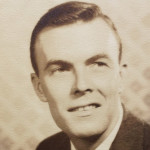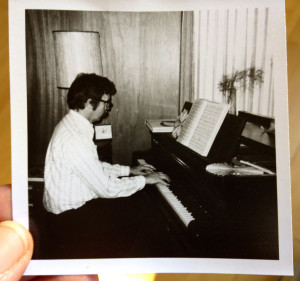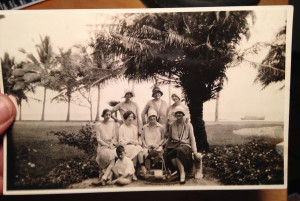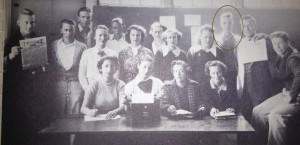 Dad died a week ago today, at 92. What follows is more hagiography than exposé; forgive me. Many factoids are wobbly around the edges. This is just my own vision. If you knew him, you may find much familiar, but I’m sure your mileage will vary. Also many of these are more anecdote than “thing.” As a result, this is the longest post I’ve ever published here, so it’s divided into five discrete pages. For the rest of the month, if and when I post, I may just publish Pops stories from the LD archives. Ninety-two years here, with a generous surplus in the “love” column: it’s the least I can do.
Dad died a week ago today, at 92. What follows is more hagiography than exposé; forgive me. Many factoids are wobbly around the edges. This is just my own vision. If you knew him, you may find much familiar, but I’m sure your mileage will vary. Also many of these are more anecdote than “thing.” As a result, this is the longest post I’ve ever published here, so it’s divided into five discrete pages. For the rest of the month, if and when I post, I may just publish Pops stories from the LD archives. Ninety-two years here, with a generous surplus in the “love” column: it’s the least I can do.
92. Dad was born in 1921 in Seattle, Washington to Jessie Harsha and Edwin Pagenhart. His mother hailed from the Ohio River Valley (her people were Scottish and English), his father from the South Dakota prairie (his people were German immigrants). They each skipped the small towns they grew up in for thrills far afield.
91. His family was in Seattle because his father was captain of the U.S.S. Lydonia, a survey vessel for the U.S. Coast and Geodetic Survey, and he was charting the Alaskan coastline in the region of Ketchikan. Not long after he was born, Dad’s family relocated for a short while to Berkeley, about a dozen blocks north from where I live now. Thereafter they returned to Washington, D.C. and Chesapeake Bay, MD, places Dad would as likely consider home as any.
![USS Lydonia, a survey vessel, skippered by Dad's father at the time of his birth. [Wikimedia Commons]](https://www.lesbiandad.com/wp-content/uploads/USCGS_Lydonia-300x181.jpg)
The only thing I can remember on my own during those Manila days before I was three: looking eye-to-eye into the face of a Filipino girl or boy from the back seat of our car as we passed the big open front window of her house (nipa), must have been stopped for a moment because we looked straight at each other. She was resting on her arms and we only stared in casual close glance about three or four feet from each other as the car moved onward. That’s all I recall of my first memory of the living world. But it took place just at the end of Dewey Boulevard [ed note: since renamed Roxas Blvd] as Manila turned into the Filipine suburb of Pasay and the road became dirt instead of pavement… auto traffic continuing south had to make its way along a winding street between houses of Filipine nipa and bamboo construction so it would explain a sudden slowdown in driving, allowing me, held in someone’s arms and looking out, to gaze into the calm face of a little girl returning the gaze.
His family returned to D.C. for a number of years, but were back to Manila again in the mid-1930s.
89. He has outlived his younger and his older sister, each of whom were very dear to him, in very different ways. Younger sister first: cancer. Older sister only just last year.
88. Every day when he returned home from his younger sister’s bedside during her short, intense cancer decline, he would walk in the door, put down his things, sit down at the piano, and play song after song, as if he were Scheherazade’s accompanist, each new tune somehow keeping his sister alive another day. He steadfastly held out for a miracle (literally: a “miracle”) up until the 11th hour. “Hope springs eternal” being his operable motto. Duly noting: this was the first family cancer death of three, each as close as possible to him.
87. When he was a child, he and his sisters had their piano practice in the early morning hours. His older sister practiced in the first slot, then him. Then his little sister. Every morning, a half an hour of piano practice, before breakfast.

86. Some years back, I took him on a tour of his old neighborhoods in Manila from the comfort of his couch, courtesy Google Maps’ street views and my laptop. He could name the school he attended, their home address (1325 Gral Luna), the works. And then see what they look like now. He was as amazed at the available visual record as I was at the accuracy of his long-term memory.

85. His father retired from the Coast Survey in the mid-1930s after contracting jaundice (I think?). Whatever it was, I have the sense that there was a tropical disease-related health thing that finally ended his working life as a ship captain and map-maker when he was in his 50s. While his father buttoned up his work in Manila, Dad and his mother and sisters travelled by train overland up to Peiping, as the city’s name was then written (later Peking, now Beijing). It was during a period of great internal strife, with Civil War still ongoing between Nationalists and Communists, and Japanese invasion on the horizon, amidst “incident” after “incident.” Dad remembers being told by his father to watch over his mother and sisters on the trip, what with him being the man of the family (he was then 14 or 15). They left Peiping for Kyoto, and from there to San Francisco’s Governor Hotel in the Tenderloin (it’s now Antonia Manor, Section 8 senior housing).
84. Dad’s father, having grown up in the wind-swept hamlet of Wessington Springs, South Dakota and having surveyed up and down the Pacific Coast and the Philippine Islands, was ready to retire in an ideal climate. He pored over maps and studied annual high/low temperature and humidity records to determine the perfect place to retire.
83. His father decided the the most temperate locale would be Santa Cruz, CA, and he bought acreage on the top of a hill overlooking Monterey Bay, next to the Powell family cattle ranch (later to become the University of California, Santa Cruz). It was the first property he ever owned after 50 years of “gub’ment” work. While his father worked with local hands to build the place, Dad’s family stayed at a hotel – Piedmont Court – at the bottom of High Street. It’s still there today, though it’s no longer a hotel. Nearly every time my family passed it on our many trips to visit his folks, Dad would point out the building and tell us about how they lived there when my grandparents’ place was being built. My kids now tell me how many times I repeat references to points of family historical interest in Berkeley. Like father, like daughter.
82. My dad ostensibly helped build the roof. His Uncle Clarence came out from southern Minnesota to help with the foundation, but legend has it that when Clarence arrived at the inordinately temperate Monterey Bay, he wheeled around and boarded the next train back to Minnesota, panicked that his crops needed to go in because of the early spring.
81. At Santa Cruz High School, Dad participated in the Science Club, the Spanish Club, Hi Tow Tong (a “secret” boy’s honor society), and the scholarship society; he served on the staff of The Trident (the school newspaper), was Commissioner of Publicity, and Manager (note the role) of the lightweight basketball team.

80. He graduated from Santa Cruz High School in 1938, with a number of Japanese American classmates who would, not many years later, become interned.

I’m sorry to hear of the passing of your dad, My mom and my thoughts are with you.
Thank you, Greg. You can let your mom know he went in peace and with a full heart.
Be Well
Beautiful. What a special man!
Polly, what a beautiful remembrance of your fascinating father. May the memories and the legacy of love sustain you.
Polly: Thank you for taking the time to write this amazing account of your Dad’s life. It only corroborates everything I felt, knew or sensed whenever I was with him. I especially appreciated the personal touches around his final days and moments. God Bless Him. And all of the family.
Love, Paul
I loved reading this. Thank you for sharing his journey with all of us.
This is amazing, and thank you so much for sharing. And it makes me realize just how much I have to learn about my own parents. Thank you for that, too.
As I said on twitter, I read this list to the soundtrack of the Beatles’ “The End:” “and in the end, the love you take, is equal to the love, you make.” You and your dad sure made a lot. I’ll not forget him.
What a beautiful account of your Dad, Polly — thank you so much for sharing it with all of us. I’m so glad you are able to know, remember, and write about so many details of his life. I laughed and cried over and over again. Many blessings to you and all your family.
Well, he certainly charmed me over the past few years, even though I never met him outside the posts on your blog. What a generous and expansive spirit this man had! And how fortunate you and your family were to be able to hold him close for so long, especially your kids being able to know him so well.
Like all your writing about him, this remembrance brims with love and humour and wonder. Thank you for sharing him with us. Peace to you and the rest of the family.
Love that your dad got part of his start in Maryland — the Eastern Shore is a special place, part of my sense of home, too.
Love love love, Polly. Just love, to you and yours and to a spirit that it sounds like has always had wings. xoxoxoxo
Polly, I am so sorry to hear that you lost your dad last week. And I’m sorry your dad didn’t get a chance to read this. What a lovely tribute to him.
Sending warm thoughts, Polly. A lovely way to meet your dad, thank you.
Beautiful, just beautiful. Thank you for sharing that insight into your father – and yourself. He sounds amazing and I believe it because it seems the apple didn’t fall far. “He never encountered a person who, after they met him, didn’t think he was one of the most charming people they knew.” That is exactly how I would describe you. I especially enjoyed reading about your parents’ love story – oh the engagement story! Thank you, really.
Polly, I was so sorry to hear about your dad’s passing. I have enjoyed getting to know him through your posts all these years–your love for him has always shone through. Wishing you and your family all the best.